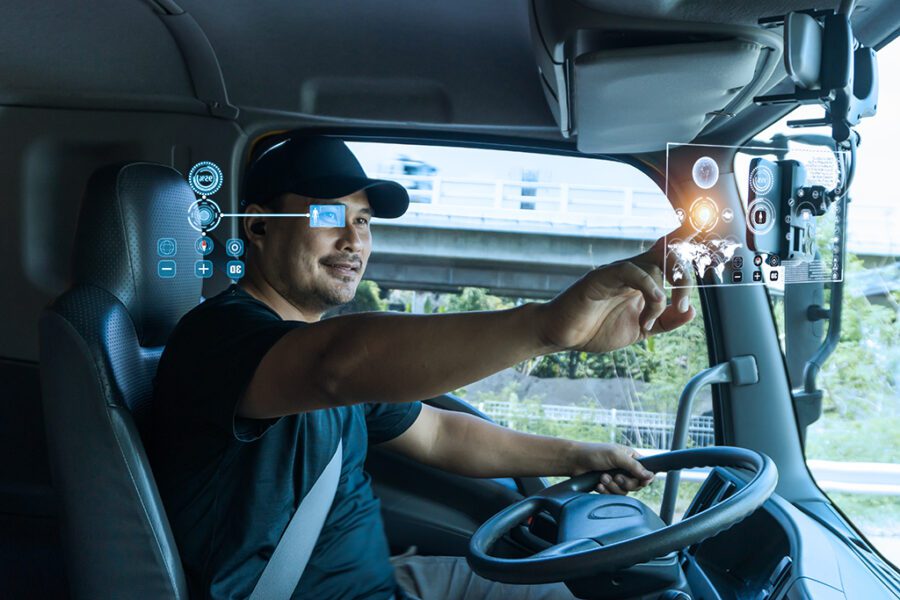
controls, technology is radically transforming the trucking industry globally
By: Osama Rizvi for Data Science Central
If you look around your room, chances are that most of the things there travelled at some stage in a truck. Trucks are responsible for moving around 70 percent in the U.S. and it employs 7 million people, fifty percent of which are drivers. While technology has been improving lives in every field but the jobs of truck drivers still remain very tough. According to one estimate, some truckers walk about 3000 miles every week. However, like everything else, technology is set to alter the future of this industry. I will try to explain briefly how.

One of the biggest change that one might see in the industry is that of self-driving trucks. While there are limitations to human endurance, a self driven robotic truck can achieve feats that are simply impossible for a human to do so. In a very interesting book, Arriving Today (the mention of which you will be frequently seeing as I talk about supply chains), Christopher Mims talks about these drastic changes. The author starts the chapter “Future of Trucking” whilst engaged in a journey in a semi-truck that has “more processing power than world’s fastest supercomputers as recently as decade ago”. The truck uses AI and the maps shown are centimeter-precise. This system is being designed by TuSimple. It performs hundreds of trillions of operations in a single second (600 trillion as stated on their website)! This artificial intelligence system learns as well. TuSimple is looking for an AI system that will require no driver and they look forward to releasing it by 2024. They expect their ATS (Autonomous Trucking System) to react 15 times faster than a human being.


Each job has its own limitations or challenges but when it comes to trucking; the most frequent challenges faced are safety and security. Each year, for instance, 700 truck drivers are killed in the U.S. and almost 500,000 accidents that involved trucks are registered every year. Despite the fact that dangerous crashes and fatal consequences of accidents had increased in past few years, there have been many developments in the system by authorities to reduce the risk of life-threatening outcomes.
One such development is of Collision Mitigation Technologies. These systems prevent damage to the driver and the public as well. It can override the driver and apply brakes besides issuing early warnings or alerts. Route Optimization is another nifty system that helps drivers to optimize their deliveries by avoiding congestion and delays. LiDAR (light detection and ranging) technology is also handy in avoiding accidents as it calculates the distance between objects and is important in threat detection.
Besides this, the adaptation of new technology has also streamlined administrative procedures and other process related issues i.e., contactless document systems, usage of video systems to capture the footage of entire process, development of analytics on shipper profiles, updating safety suite systems or monitoring the process of shipper changes.
However, technology is not only limited to the on-going internal processes but it also includes the upgradation of the mediums used in the transportation industry. From powertrains reducing the cost of shipping, accelerating the time frame to aerodynamics enhancing the fuel efficiency, from additional security features – increasing the life of the vehicle to telematics – transforming the whole experience, from software and diagnostic tools to drivers’ comfort, from several trucking strategies for reducing repeated trips to autonomous trucking, modern technology has turned the tables for the industry.

Despite the progress, many challenges remain. Where machinery and automation has benefited the industry, there still is a dire need to upgrade the basic work process, to achieve a well-organized approach and to better the administration. Also, the automation itself face some challenges. While a shift to driver-less trucks might not affect the overall availability of jobs in the industry it will certainly impact the wages and put downward pressure on it. The silver lining is that it might help to end what Mims has referred to as “wage slavery” of drivers and give them a break from their tedious, physically demanding and alienating nature of job. This also speaks to the wider benefits of automation about which we shall talk about in a different article.
While reading Arriving Today and writing this article, I came across jobs such as trucking, working in an Amazon warehouse, and others. The robotic nature, the extraordinary strict and regimented routine, calculated bathroom breaks and performing hundreds of actions every single day to make it your muscle memory (like the employees of UPS, for example, do), makes one wonder if these human beings have transformed into machines. There is a reason automation and robots sound so promising to me. It will not only help us break this viscous circle but also free more time to spend with our family, friends and nature. Something that we humans are supposed to do.

